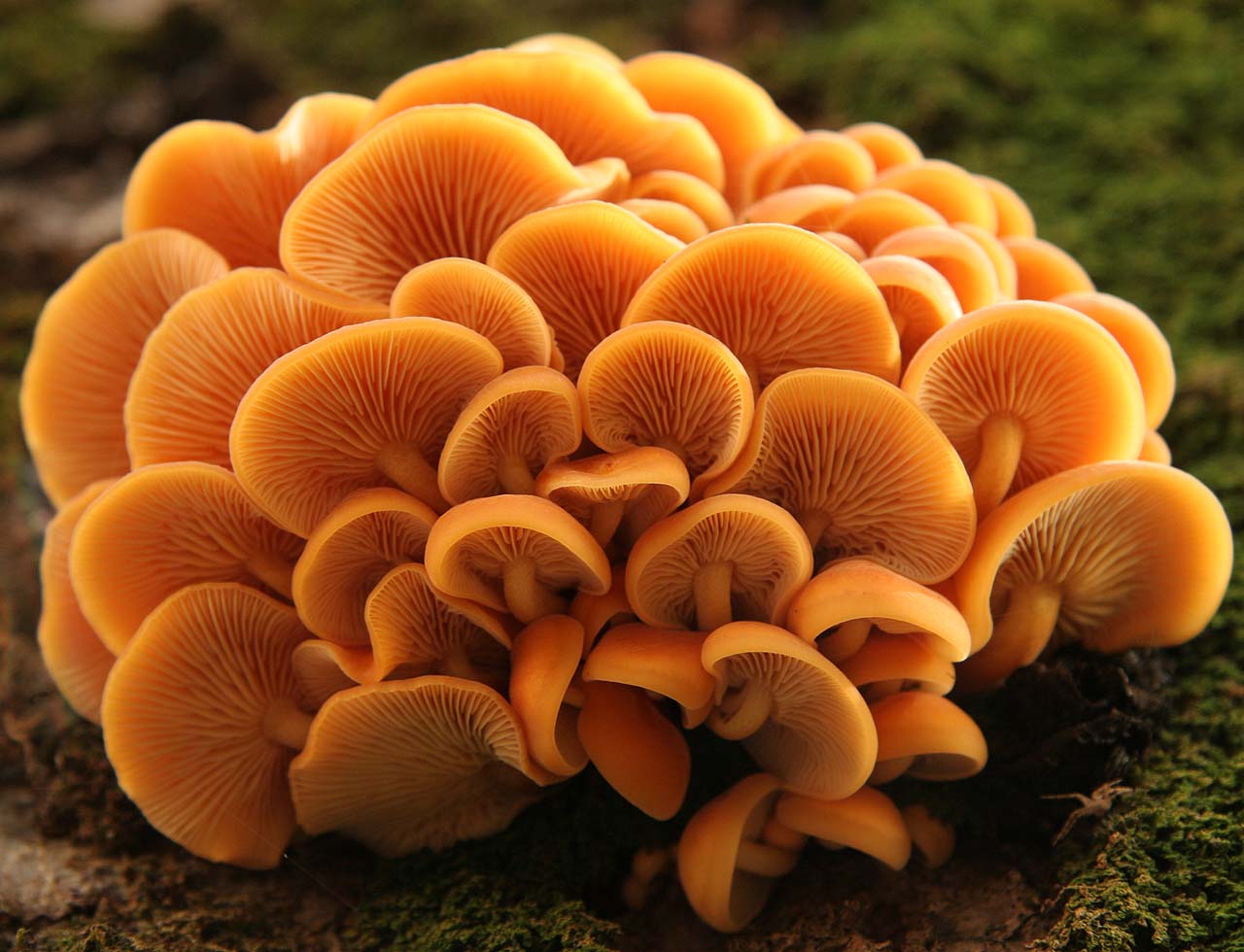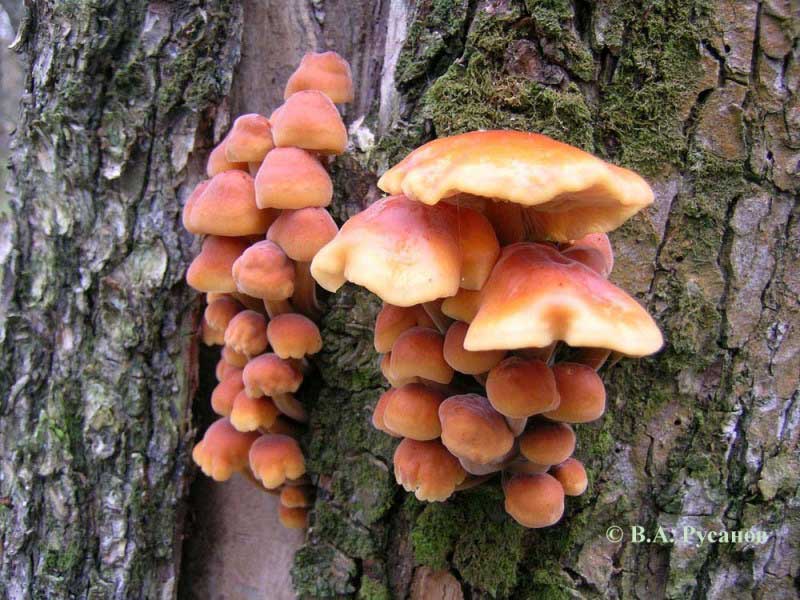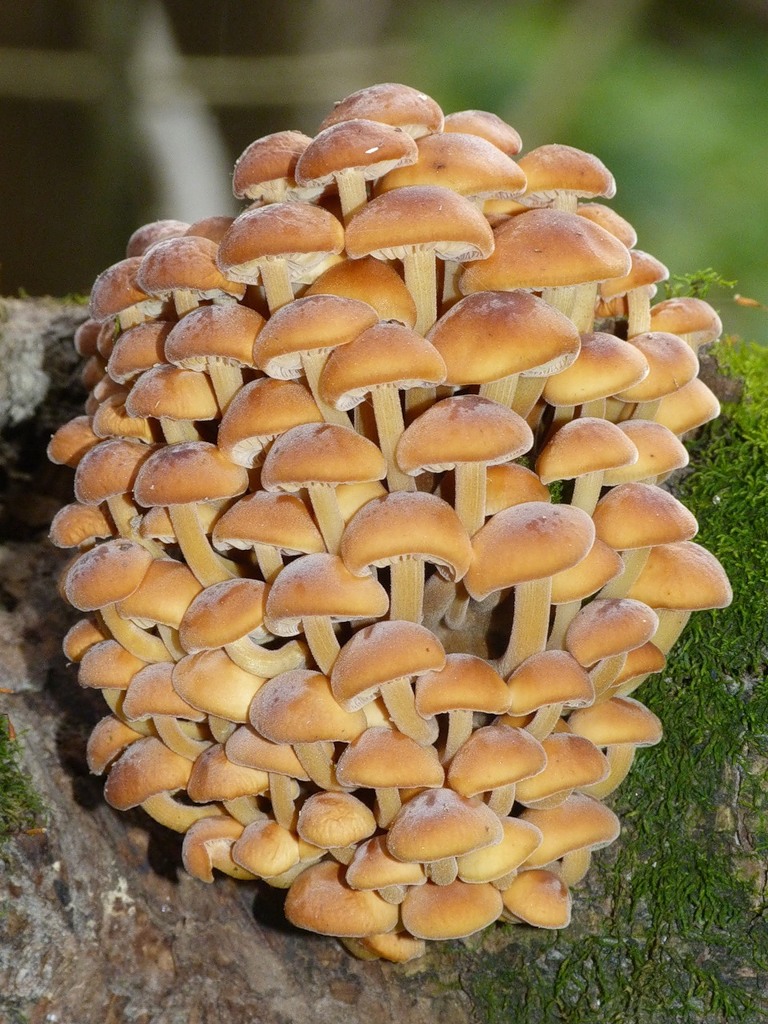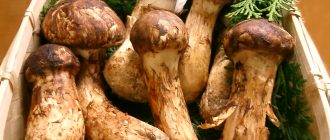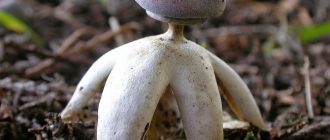Winter edible mushrooms: a description of what mushrooms look like in the forest (with photo)
Latin name: Flammulina velutipes.
Genus: Flammulina.
Family: Ordinary, also belong to the Negniyuchkovy family.
Synonyms: Agaricus velutipes, Collybia velutipes, Collybidium velutipes, Gymnopus velutipes, Myxocollybia velutipes.
Russian synonyms: velvety-legged flammulina, velvety-legged colibia, winter mushroom. In the West, they are most often found under the Japanese name "enokitake".


Hat: rounded-convex, flattening with age. The diameter is from 2 to 8 cm, but some large specimens can reach 10 or even 12 cm. The color of the cap varies from yellow or honey to orange-brown. In most cases, the edges of the cap have a lighter shade than the central area. Mucous, smooth, with slight drying takes on a glossy appearance
Pay attention to the caps of edible winter mushrooms by looking at the photo


Leg: cylindrical, tubular, dense, velvety, 3-8 cm high, up to 1 cm thick. The upper part has a lighter shade (yellow), and the lower one is darker (brown or red).
Flesh: thin, firm at the lower edge of the stem and softer at the cap. White or light yellow, with a mild pleasant smell and taste.
Plates: rare, slightly adherent to the stem, sometimes shortened. The color of the plates in young individuals ranges from cream to yellowish-white, darkens with age.
We offer you to see a few more photos of the winter honey agaric in the forest:


As you can see, they have a brighter color than representatives of other types of edible honey agarics. Knowing what winter mushrooms look like in the photo, it will be much easier for you to find them in the forest.
Edible: conditionally edible, belongs to the 4th category.
Cultivation of flammulina
In many Asian countries, flammulina has been introduced into industrial culture on non-food waste from agricultural production and woodworking industries. Unfortunately, information was dispersed on the Internet that winter honey mushrooms are sold in supermarkets frozen and pickled under the name "honey mushrooms" on the price tag. And, allegedly, therefore, it is easier to find Flammulina in the supermarket in winter than in nature. Alas, this information is erroneous. Both the Veres company and Asian producers sell another mushroom under this name - Foliota nameko. Flammulina, on the other hand, is grown in Asia in a special way, in the form of bunches of thin, thin mushrooms, similar to nails. And they are called Enoki.
Winter variety of honey agarics: photos and how to distinguish edible mushrooms from false ones
Application: used in cooking and medicine. They are pickled, salted, fried, caviar, soups and sauces are made from them. In young specimens, only the lower part of the leg is removed; in mature specimens, only the caps are taken. Mushrooms are very popular in Japanese cuisine. In medicine, it is used for the treatment and prevention of benign tumors - fibromas, fibroids, adenomas, mastopathy and other types of oncology. Used for thrombophlebitis and increased blood clotting.
Similarities and differences: the winter species of honey agaric has no false poisonous counterparts. Still, their appearance can be confused with summer honey ages and spindle-footed collibia. However, it is almost impossible to find them near the winter honeydew. The fact is that the time of their fruiting is completely at odds with the season of flammulina activity. But be that as it may, it is necessary to know some of the differences between them.


As you can see in the photo, you can distinguish winter mushrooms from false ones by the presence of a ring on the leg: in edible species it is clearly visible, while in false ones it is completely absent.


Collibia spindle-footed is a fruit body of dubious food quality. The cap of the mushroom has a pronounced reddish-brown color.The leg is often twisted, tapers noticeably downward, and has a reddish tint. Comparing photos and descriptions of winter mushrooms with false species, you can easily determine where and which fruit bodies.
Distribution: winter honey fungus grows in the northern temperate zone, being a parasitic fungus. Prefers stumps, dead wood, live and damaged trunks. Most often, flammulina can be found on deciduous tree species: willow, poplar, aspen, ligature, maple, etc. It grows on conifers much less often, sometimes it chooses dead wood.
Description of the mushroom Flammulin
 Winter honey agaric Flammulina hat 2-9 cm in diameter, initially convex, then flat, smooth, slimy, rusty-yellow, yellow-brown, darker towards the center, shiny when dry.
Winter honey agaric Flammulina hat 2-9 cm in diameter, initially convex, then flat, smooth, slimy, rusty-yellow, yellow-brown, darker towards the center, shiny when dry.
The leg of flammulina is 3-10 × 0.5-1.0 cm, central, cylindrical, made, dense, rigid, yellowish at the plates, brown-brown to the base, black-brown, velvety pubescent, tapered elongated.
The flesh of the flammulin mushroom is soft, yellowish, with a mild pleasant taste and a weak mushroom smell.
Flammulina plates are weakly adherent or loose, frequent, thin, light, yellowish-fawn.
Spore powder of flammulina creamy white. The spores of velvety-footed flammulina are 8-9 × 5-6 microns, oval, smooth, colorless.
 Flammulina
Flammulina
Where does Flammulina grow? Flammulina grows on wood, in hollows, on stumps of deciduous, occasionally coniferous trees, in large groups and intergrowths. On old hardwood. Honey mushrooms bear fruit especially abundantly on tall and thick old aspen, poplar, willow and maple stumps and logs lying on the ground.
 Flammulina grows on trees and stumps Winter mushrooms of Flammulin can settle in a garden with fruit trees, gradually destroying them.
Flammulina grows on trees and stumps Winter mushrooms of Flammulin can settle in a garden with fruit trees, gradually destroying them.
On the wood of deciduous (rarely coniferous) trees in forests and gardens. Prefers elms, poplars, willows, beeches. All year round, but mainly from November to February. In summer it is very rare, and in small groups. Can grow in large numbers in spring.
The fungus prefers hardwood, especially poplar and willow.
Flammulina belongs to the ecological group of xylophytic fungi, that is, fungi growing in forests on stumps, dead wood, even deciduous trees and on weakened trees.
The growing time of flammulina: more massive - from October to December, and during thaws - also January and February. Our reports on the search for the winter mushroom are here.
This mushroom is also called winter mushroom, winter mushroom, in Latin, winter mushroom is called flammulina velutipes, and in Ukrainian - winter mushroom.
When do winter mushrooms appear and how to find them in the forest
The period when winter mushrooms appear depends on the climatic characteristics of individual territories. Traditionally, the first harvest appears at the end of September - early October. The peak of abundant fruiting occurs in November-February, sometimes a large number of mushrooms can be observed in May. Thus, under certain weather conditions, it is possible to collect winter mushrooms almost all year round.
One of the characteristic features of flammulina is that it tolerates frost well. During the frost period, the mushroom freezes, but does not die. At the very first thaw, its growth resumes, and the structure of the fruiting body itself returns to its flexibility and original appearance. I must say that you can find this mushroom even under a layer of snow. It can be easily collected both frozen and thawed, because even with severe frosts, it will not lose its taste.
Knowing when winter mushrooms grow, and under what conditions this process takes place, many mushroom pickers do not miss the opportunity to visit the forest during the cold season. They may find that during frost, honey agaric caps begin to crumble when pressed, but you should not be afraid of this. In a warm room, they will thaw and restore their former elasticity.
How can you find winter mushrooms in the forest? Fans of "quiet hunting", who have many years of experience in this business, note that this is not an easy task. In addition to fallen trees and stumps, it is necessary to look into the hollows. Sometimes there you can find a whole "army" of honey-golden "soldiers". In addition, when picking mushrooms, you should not only look at your feet, but also look up. Often, winter mushrooms grow exactly at a height that can reach up to 3 m.In this case, it is worth taking with you a long stick with a hook, thanks to which it will be easy to remove the mushrooms from the tree.
How quickly winter mushrooms grow and when can they be harvested
Also, many novice mushroom pickers are interested in how quickly winter mushrooms grow? As you know, all mushrooms, without exception, grow very quickly. If the weather is favorable for the growth of the fruit body outside the window, then after 2-3 days you can go to the forest. Under what circumstances does the growth of the winter fungus occur? In this case, everything will depend on the weather conditions. In the absence of strong and prolonged frosts, the fruit body can grow in a few days. According to studies, flammulina per day can increase by 1-2 cm. And vice versa, if frosts come, then the growth of such honey agarics practically stops, but only until the first thaw. It is with her arrival that the mushroom continues to grow, delighting with its variegated color of the eyes in the "bare" forest. Therefore, in order to know when you can go to collect winter mushrooms, you need to navigate by the weather, because the growth of fruit chalk depends on it.
The surface of the cap of the winter honeydew is slightly covered with mucus, which does not disappear even when boiled. In addition, it is customary to remove the stem of the fruiting body completely, since it is too hard. There is also information that the pulp of the mushroom may contain a small amount of toxins, so it must always be heat treated. To do this, after cleaning, the winter mushroom is boiled in salted water for at least 20 minutes, and then they begin to prepare dishes.
Share article:
Flammulina - Edible Winter Mushroom
The winter in our city has turned out to be extremely warm today. Nature reacts to everything that happens sensitively - a very unusual picture opens up to the attentive gaze of the observer. Trees and shrubs right in the city are covered with hundreds of mushrooms!
This mushroom is unknown to the majority of St. Petersburg lovers of quiet hunting at all. Nevertheless, it is not at all rare, and it is not necessary to go far for it: whole bunches flammulins are found right within the city - in the Udelny Park, a hundred meters from Moskovsky Prospekt, in the park of the Forestry Academy, on St. Isaac's Square, among colorful sightseeing buses and frozen passers-by.
The scientific name of the fungus is Flammulina velutipes. In boring Latin names, you sometimes hear amazing poetics - the generic name literally translates as "Fire mushroom", and specific - as “velvety-legged "... In general, the name corresponds to the appearance - the caps of the mushrooms of a bright yellow, honey color "burn" with lights in a dark winter forest. It was winter - this year I had to collect them in January! So if in winter in the forest among the snowdrifts you come across a man with a basket, do not rush to twist your finger at your temple and call an ambulance. It's just that someone knows more about mushrooms than you do.
Mushroom is also called winter honey - in the warmer regions of Russia, he pleases mushroom pickers all winter, every year and without interruption.
The mushroom is beautiful and decorative in its own way. An even, shiny cap in adults flammulin reaches 5-6 centimeters, the leg is about the same in length. The bulk of the fruit bodies are smaller - from one to three centimeters. The smell is strong, pleasant, really mushroom. Regarding the place of growth, flammulina is unpretentious, in the forest it can be found on living deciduous trees, as well as on stumps, dead wood, brushwood.In the city, flammulina is most often found in parks and squares among willows, at a height of about half a meter above the ground.
The mushroom cap is usually covered with a layer of mucus, which protects it from light frost. In the process of evolution, flammulin acquired an unusual property - the water in its cells is replaced by a kind of glycerol complex, which does not allow ice to crystallize. If frost hits, it's also okay. A few days of thaw are enough - the mushroom will thaw and grow again. So do not get lost next fall, the main fruiting of this mushroom falls on the end of October-November. By the way, in the gloomy late autumn, when you lose heart and you don't want to do anything, a walk through the forest improves your mood in a wonderful way. The winter forest is surprisingly deserted, quiet. For a full day of walking, you most likely will not meet anyone, so there will be no one to laugh at your snow-covered basket and mushroom picker cane.
The rule, which applies not only to flammulina, but also to mushrooms in general, is that mushrooms collected in the city cannot be eaten! The fact is that mushrooms very actively accumulate various substances, including substances harmful to the human body. This rule also applies to mushrooms grown in the immediate vicinity of roads and railways, around large industrial enterprises and similar environmentally unfavorable places.
For the sake of fairness, we note that flammulina is far from the only mushroom that pleases us in the "non-mushroom" time. To all familiar mushrooms can also be harvested in late autumn. Until the very snow in the forest, you can find some ryadovki, oyster mushrooms abundantly growing on wood, impudently sticking out among the fallen needles of hygrophors. But only flammulina is capable of continuing to grow after strong multi-day frosts. By the way, the optimum temperature for the beginning of fruiting for this mushroom is 3-5 degrees.
Growing Flammulina
Flammulina is edible and, according to many, delicious. In Japan, it is grown commercially and sold. Scientists believe it has anti-cancer properties. Scientifically confirmed the antiviral activity of the substances contained in the winter mushroom, as well as the presence of many vitamins necessary for the human body.
Gardening enthusiasts can try growing the mushroom on their own. Specially prepared pieces of wood and nutritious mixtures will serve as a "bed" here. Flammulin does not disdain substrates based on bran, sunflower husk, sawdust, buckwheat husk, ground corn cobs. The substrate is mixed with gypsum and subjected to heat treatment, after which it is packaged in sterile bags, at the same time infecting with mycelium - the very mycelium that will give rise to a new crop. Flammulina mycelium can be purchased in the same place where they sell oyster mushroom and mushroom mycelium, who is looking for - he will always find.
With strict adherence to the technology, and it implies constant control over humidity and a tough temperature regime, after 45 days you can harvest the first crop! Grown "in captivity" mushrooms are similar to forest ones, only slightly less intensely colored. The taste does not suffer from this, the mushroom is just as useful. With proper care of the substrate and timely removal of the resulting "bouquets", you can count on two or even three waves of fruiting. Comparison with a bouquet is quite justified - dozens of mushrooms of different sizes grow from one base. When grown on an industrial scale, for every three liters of nutrient substrate, up to one and a half kilograms of premium mushrooms are obtained!
Flammulina, both grown and harvested in the forest, can be prepared in any way possible - it is boiled, fried, pickled.Experts recommend preparing them for it, the so-called mushroom caviar, for which pre-boiled mushrooms are passed through a meat grinder, fried onions and fresh green onions, peppers, vegetable oil are added. Bon Appetit!
A wonderful decoration for the New Year's table, isn't it? But not everyone will be able to believe that you collected these mushrooms in the forest yourself a few days ago ...
Good luck and new amazing discoveries!
Dmitry Pesochinsky
Photo by the author
10788
Tags:
mushrooms winter




